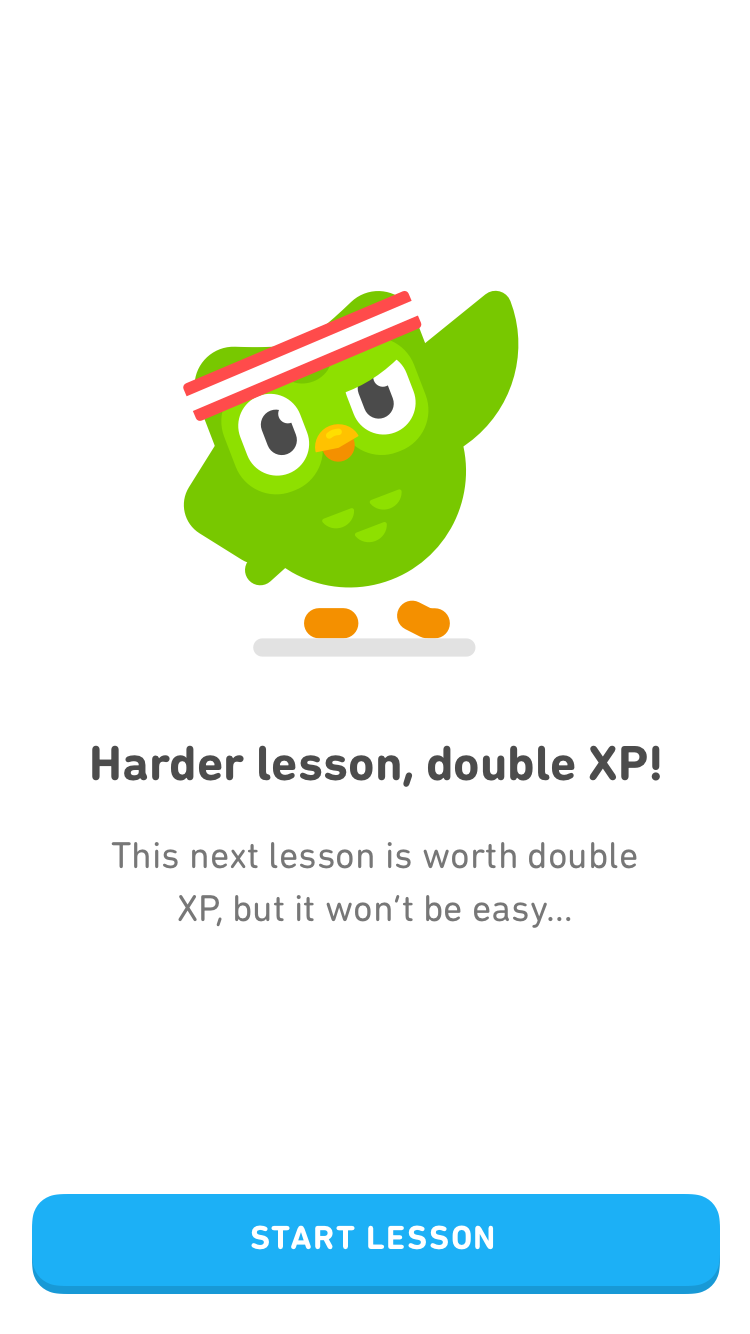One of Duolingo’s core product principles is that by making language learning enjoyable, our learners will be more willing to stick with it. Learning a language is hard, so it’s important that we make our app fun and exciting to keep up momentum. At the same time, we think it’s important for people to regularly challenge themselves with tougher lessons, even if it might be outside their comfort zone.
This past summer, I worked with Duolingo’s Product team to come up with new ways to make language learning both challenging and fun. As a gamer and product manager with experience developing mobile apps, this was an enjoyable assignment. I had the opportunity to research videogames and best practices on gaming mechanics. This led us to test some theories about how best to increase difficulty for our learners, while simultaneously enhancing their experience using Duolingo.
What is pacing, and why does it matter?
I’m sure we’ve all had this experience: we’re watching a movie or reading a book, and it feels very flat. There’s no variation in mood or excitement; we’re simply moving along from one scene to the next.
Enter pacing. It’s a technique used by storytellers of all kinds to make narratives more exciting. You have rising action and rising tension, which makes the climax – and subsequent resolution – all the more satisfying. Pacing is also a key element of game design, and is frequently employed by game designers to ensure that players remain engaged. You don’t want a level to be too easy because then a player will just breeze through it, effortlessly overcoming obstacles and never breaking a sweat. At the same time, you want to avoid making it overly difficult: if something is too hard, it can start to feel unfair, leading users to ultimately quit. Which is definitely not what we want to happen!
Within the Duolingo app, we aim to give learners flexibility in their language learning journey. From allowing you to choose your daily goal to encouraging the hover approach for tree progression, we want learners to interact with Duolingo in such a way that it helps them both learn and sustain their habit. However, simply going through the lessons daily can sometimes start to feel monotonous, especially when you have familiarity with the material, or have been using our app for a long time.
Ready for a challenge?
This led to the idea for Hard Mode: a way to vary the lesson experience, while allowing learners to practice their language skills! Hard Mode is a special type of lesson that randomly appears for learners after they’ve made some initial progress. It’s designed to challenge learners by serving them higher-level content. If a learner doesn’t complete a hard mode lesson, we don’t show it again for that skill + level combo, so that they can comfortably learn at their own pace.

At first, we were nervous that more difficult lessons would upset many learners. A Hard Mode session can potentially take much longer than a normal lesson, so learners who expect a casual session of Duolingo might be caught off guard. We also weren’t sure if learners would be willing to take the lesson for a reward of 20 XP. Finally, we were unsure if the difficulty level might cause learners to get too frustrated and not return.
When we reviewed our experiment results, we were excited to find that engagement remained neutral, and D14 retention (learners who come back for two weeks) had actually increased slightly (+0.811%). This gave us a boost of confidence in exposing harder content to learners. Harder content provides a learning benefit because it not only stretches your capabilities, it also encourages you to consider your responses more carefully before submitting an answer. As an added bonus, you might get an adrenaline rush from a tough lesson – and it’s extra-rewarding when you successfully complete it!
You might be wondering: were the Hard Mode lessons really more difficult? To answer this, we looked at a few different metrics, and here’s what we found:
- Session completion rates were lower for hard mode lessons than normal lessons
- On average, learners were losing more hearts in hard mode lessons
- On average, learners were utilizing more hints in hard mode lessons
What’s Next?
This is just the beginning of our explorations with Hard Mode, and our team is coming up with different ways to surface more challenging content to learners. We are investigating playing with time (adding limits, bonuses and more) to increase the excitement of taking a lesson. We have also heard learners request more difficult lessons that allow you to test certain types of skills (ex. more speaking and listening), or are more rigid about how you answer a question (requiring accents, no hints, etc.). There’s lots of room to explore. Rest assured: our team will continue to do our best to keep things fun and interesting for as many of our learners as possible!